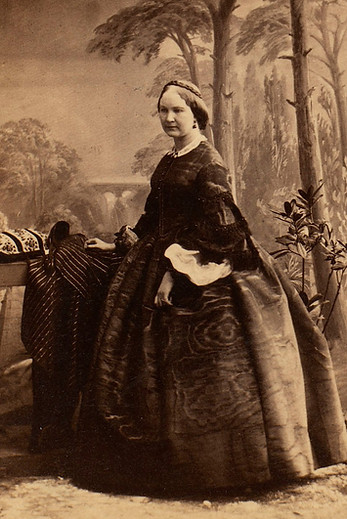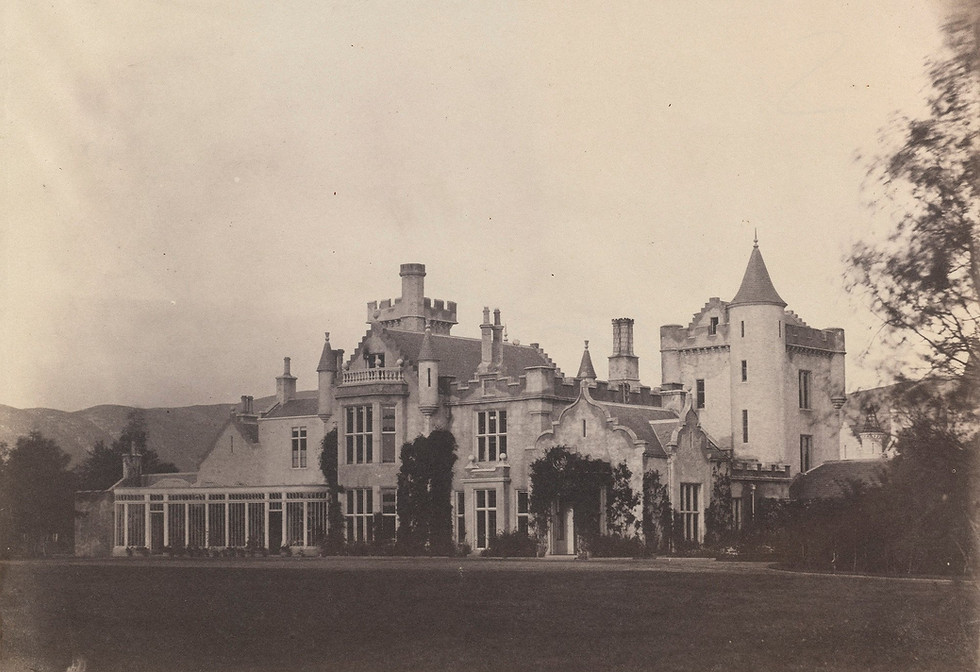


The castle’s forerunner, also called Balmoral, was a “pretty little castle in the old Scottish style” recounted the Queen of her visit in 1848, with a “nice little hall, with a billiard-room; next to it is the dining-room”. And although Balmoral and its estates became synonymous with the royal family’s love of deer stalking, the fruits of which appeared with predicable regularity on the castle’s dinner menus, it seems that first visit wasn’t such a shooting success for her husband, Prince Albert.
“When I came in at half past six”, recounted the Queen, “Albert went out to try his luck with some stags which lay quite close in the woods, but he was unsuccessful. They come down of an evening quite near to the house”.
The couple would purchase the property outright in 1852 and, just two weeks after this dinner, the Queen would lay the foundation stone, 90 metres away, for a new rebuilt and much larger Balmoral Castle with its iconic turrets. It would be completed in 1856 with the original house being demolished.
Queen Victoria was just 34 years-old, already a mother of eight, when she and her husband hosted this dinner. Joining the Queen, according to the official Court Circular, was the Queen’s mother, the Duchess of Kent; along with a cousin Count Mensdorf and Lady-in-Waiting, Lady Augusta Bruce. Earlier in the day the “woods near Balmoral were driven for deer”, and the Queen had travelled in an open carriage “to meet His Royal Highness and the party returning from shooting”.
Victoria’s mother, the Duchess of Kent, had famously not always enjoyed royal dinners. When the childless King William IV was alive, he had disdain for his sister-in-law’ Duchess and her chief advisers whom he viewed as evil and meddling. The King famously and despairingly – and perhaps drunkenly - blurted out “that woman!” during a speech at a state banquet, as she sat to his side, as he royally vowed to live long enough to see his niece, Victoria, turn 18 so that her mother the Duchess of Kent could not be Regent. By almost a month, the King’s wish came true.
From the 1850’s it became a tradition for the royal family to be served venison every day they were in residence at Balmoral. A year after this dinner, the Queen’s Maid-of-Honour, Hon. Lady Eleanor Stanley, wrote to her father from the castle and revealed there were “twenty-two haunches in the larder”, and that “I suppose shall go on eating one every day while we are here”.
A week earlier, still waiting for Prince Albert to down his first stag, Lady Stanley warned her father of the pending culinary tedium:
“We have had no venison yet, but I hear that when it once begins we have a haunch every day till we go, and while we are eating it we are entertained with the story of where it was shot, and which day, and how the Prince got a shot at him, also how many shots it took to finish him, and whether he was well shot”.
While a haunch of venison became almost routine at the dinner table, on this night the venison was served in the form of spherical puréed rissoles steamed in a strong game consommé mixed with cream and redcurrant jelly: Les Quenelles de Venaison.
At Balmoral Prince Albert appeared “in full Highland dress of Royal Stuart tartan every night”, remembered Lady Stanley before revealing with a dig, “but I don't think it becomes him, he is rather too fat and substantial for it".
Prince Albert’s Germanic fingerprints are revealed with a dessert of Himbeeren Kalteschale (Kaltschale): a chilled semi-sweet raspberry soup flavoured with cinnamon and vanilla and thickened with tapioca.
The Prince introduced the royal court to many German desserts from his childhood home in Coburg which continued to appear – written in German – on Queen Victoria’s menus well into her widowhood. Examples from the royal menus included Pouding Sax-Weimar; Mehlspeise mit Fruchten; Sprütz Gebackenes; … even when a chocolate soufflé appeared on Queen Victoria’s menus, it could appear as Auflauf von Chocolade if it had been one of Prince Albert’s childhood favourites.
almoral Castle, as we know it today, hadn’t even been built when Queen Victoria hosted this family dinner in 1853.
B
Her Majesty's Dinner
12th September 1853
Profitrolles au consommé: Game consommé thickened with tapioca served alongside hors d'oeuvres of savoury profiteroles filled with a purée of game meats | Crême au Vermicelli: Cream of chicken soup with vermicelli noodles | Le Turbot au four: Baked turbot | Les Merlans frits: Fried battered whiting drizzled with lemon | Les Harengs grilles: Grilled herrings | Le Gigot d'Agneau braises: Braised leg of lamb | Le Boeuf rôti: Roast beef | Les Filets de Bôeuf piqués frits: Fried filets of beef that have first been dipped in a mixture of mustard and vinegar | Les Vol au Vent à la Bechamell: Vol au Vent pastry shells filled with chopped chicken and ham bound with Bechamel sauce | Les Quenelles de Venaison: spherical puréed rissoles steamed in a strong game consommé mixed with cream and redcurrant jelly | Les Perdreaux: Roast partridges | Les Grouses: Roast Grouse | Les Pommes au Riz: Stewed apples with creamed rice | Cranberry Tart | Les Pommes de Terre frits en Natte: Fried potato twists | La Salade Hollandaise: Salad of asparagus in Hollandaise sauce made from egg yolks and lemon juice | La Gelée à la Russe: A mould of diced potatoes, carrots and turnips mixed with baby-peas and green beans; bound in mayonnaise and garnished with slices of pickled tongue, truffles and shredded lobster meat | Les Croquette de Pommes de Terre: Potato croquettes | Le Gateau Meringue: Meringue cake | Himberen Kalteschale: Chilled semi-sweet, thickened raspberry soup | Buffet: Rt Mutton Roast Mutton.
Royal Menu Collection / © Jake Smith

Maid-of-Honour to Queen Victoria, Honourable Eleanor Stanley: in 1854 she wrote to her father from Balmoral and recounted that Prince Albert "had dragged himself on all fours about two hundred yards, passing by two hinds and three poor stags, and was very near within shot of a very fine one which he wanted, they all bolted ; and though he fired at his stag, it was too long a shot and it did nothing, so he came home venisonless".
(Photo: Royal Collection Trust
© His Majesty King Charles III, 2025)

Ultimately demolished to make way for a new castle, "old" Balmoral was purchased by Queen Victoria and Prince Albert in 1852.
(Photo: Royal Collection Trust
© His Majesty King Charles III, 2025)

"The Prince is just come, in great spirits, having shot four stags ; I suppose we shall see them laid out by torch-light this evening ; that is a ceremony I don't admire ; it was done on Saturday, but there was only one stag." - Lady Eleanor Stanley, Balmoral, 19 September, 1854.
At the entrance to old Balmoral Castle, Queen Victoria, the Duchess of Kent, and the royal children in the doorway receiving stags pointed out by Prince Albert.
Signed and dated bottom left: Carl Haag 1854. Royal Collection Trust
© His Majesty King Charles III, 2025


